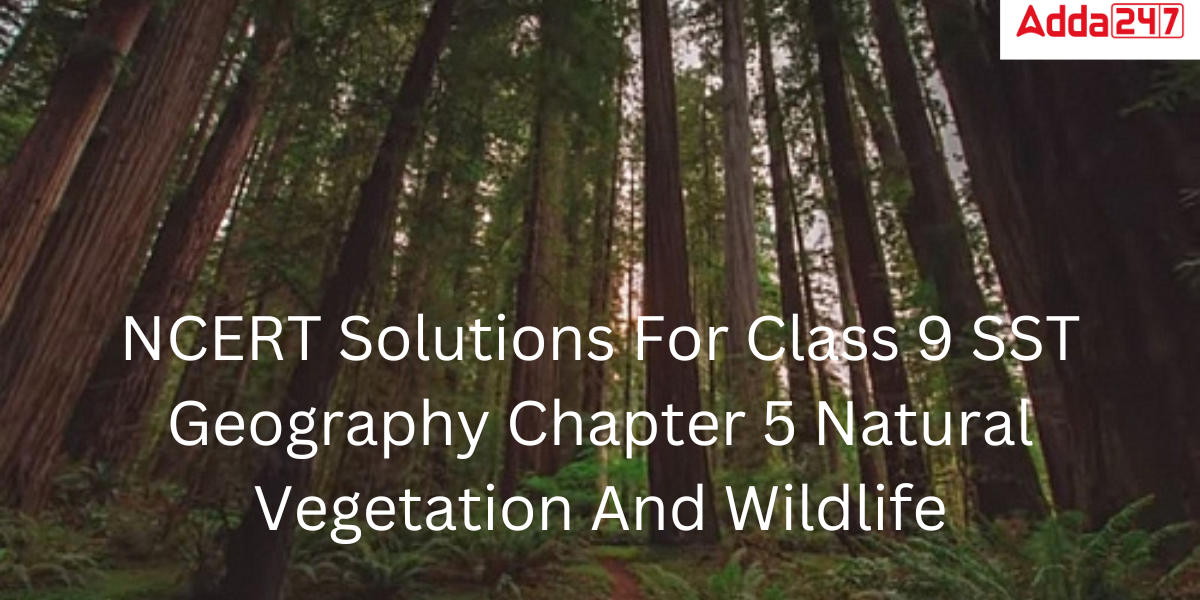NCERT Solutions for Class 9 SST Geography Chapter 5 Natural Vegetation and Wildlife Notes
NCERT Solutions for Class 9 SST Geography Chapter 5 Natural Vegetation and Wildlife notes are provided in this article. NCERT Solutions for class 9 is the finest resource for getting a high score on the class 9 Examination. Adda247 Expert faculty team prepared NCERT Solutions for Class 9 SST Geography Chapter 5 Natural Vegetation and Wildlife exercises of that chapter for a better grasp of the topics. These NCERT Solutions answer all questions in an easy and simple manner. These solutions will help you understand the concepts covered in the chapter completely. By writing these answers in the exam students will undoubtedly be able to achieve high scores. Keep learning with Adda247.
NCERT Solutions for Class 9 SST Geography Chapter 5 Natural Vegetation and Wildlife Notes pdf
NCERT Solutions for Class 9 SST Geography Chapter 5 Natural Vegetation and Wildlife pdf is given in pdf format so students can easily download it for future use. Click here to download NCERT Solutions for Class 9 SST Geography Chapter 5 Natural Vegetation and Wildlife
Class 9 SST Geography Chapter 5 Natural Vegetation and Wildlife Video Explanation
Class 9 SST Geography Chapter 5 Natural Vegetation and Wildlife Summary
In Class 9 SST Geography Chapter 5 Natural Vegetation and Wildlife, Students will learn about the climatic conditions of the different parts of the country with Natural Vegetation and Wildlife.. India ranks fourth in Asia and tenth in the globe for plant diversity. India is one of the nations with the greatest variety of plants and animals due to its unique biodiversity and natural vegetation. Before going to the NCERT Solutions for Class 9 SST Geography Chapter 5 Natural Vegetation and Wildlife, Let’s take a look to the topics included in the chapter
1. Relief: Land and Soil
2. Climate
- Temperature
- Photoperiod
- Precipitation
3. Types of Vegetation
- Tropical Evergreen Forests
- Tropical Deciduous Forests
- Tropical Thorn Forests and Scrubs
- Montane Forests
- Mangrove Forests
NCERT Solutions for Class 9 SST Geography Chapter 5 Natural Vegetation and Wildlife Questions with Answer
1. Choose the right answer from the four alternatives given below:
(i) To which one of the following types of vegetation does rubber belong to?
(a) Tundra (b) Himalayan (c) Tidal (d) Tropical Evergreen
Answer: Tropical Evergreen
(ii) Cinchona trees are found in the areas of rainfall more than
(a) 100 cm (b) 70 cm (c) 50 cm (d) less than 50 cm
Answer: 100 cm
(iii) In which of the following state is the Simlipal bio-reserve located?
(a) Punjab (b) Delhi (c) Odisha (d) West Bengal
Answer: Odisha
(iv) Which one of the following bio-reserves of India is not included in the world network of bio reserve?
(a) Manas (b) Gulf of Mannar (c) Nilgiri (d) Nanda Devi
Answer: Manas
2. Answer the following questions briefly.
(i) What factors are responsible for the distribution of plants and animals in India?
Answer:
Relief factor: Land, Soil
Climate factors: Temperature, Photoperiod (Sunlight), Precipitation
(ii) What is a bio-reserve? Give two examples.
Answer: Biosphere reserves are for the preservation of both plants and animals. The government of India established 18 Biosphere Reserves to save sizable tracts of the natural environment.
Example: Nilgiri Biosphere Reserve
Sundarbans Biosphere Reserve
(iii) Name two animals having habitat in the tropical and montane type of vegetation.
Answer:
Two animals having habitats in tropical vegetation are— Tiger and Elephant.
Two animals having habitat in montane vegetation are— Kashmir stag and spotted dear.
3. Distinguish between
(i) Flora and Fauna
Answer:
| Flora | Fauna |
| This category covers all types of living plants. | This category includes every living animal. |
| Food is produced on an autonomous basis. | For food, fauna depends on other species. |
| “Botany” is the study of plants. | Zoology is the study of animals. |
| Examples of Flora are Forests and grassland. | Examples of Fauna birds, animals, fish, insects, |
(ii) Tropical Evergreen and Deciduous forests
Answer:
| Tropical Evergreen | Deciduous forests |
| The tropical evergreen forest is incredibly dense. | In comparison to tropical evergreen forests, tropical deciduous woods are less thick. |
| There are tropical evergreen forests in areas with more than 200 cm of average rainfall. | There are tropical deciduous forests there where the annual rainfall is between 70 cm and 200 cm. |
| Asia’s northeastern states, the Andaman and Nicobar Islands, the Western Ghats, Peninsular India’s coast, Tamil Nadu’s coast, and other places have evergreen forests. | Jharkhand, West Bengal, Chattisgarh, Orissa, the Himalayan Foothills, Uttar Pradesh, and Madhya Pradesh are among the states that have deciduous forests. |
| Rubber, Rosewood, Mahogany, and Ebony tress are found in evergreen forests. | Teak, Sal, Mahua, Bamboo, trees are found in tropical deciduous forests. |
4. Name different types of vegetation found in India and describe the vegetation of high altitudes.
Answer: Different types of vegetation found in India are
(i) Tropical Evergreen Forests
(ii) Tropical Deciduous Forests
(iii) Tropical Thorn Forests and Scrubs
(iv) Montane Forests
(v) Mangrove Forests
Temperate forests and grasslands typically give place to Alpine vegetation at elevations greater than 3,600 metres above sea level. The common trees in these forests are silver fir, junipers, pines, and birches. They eventually converge into the Alpine grasslands through bushes and other vegetation. Nomadic tribes like the Gujjars and the Bakarwals make considerable use of these for grazing. Mosses and lichens make up the vegetation of the tundra at higher altitudes.
5. Quite a few species of plants and animals are endangered in India. Why?
Answer: Species that are highly close to extinction are referred to as endangered species. The primary reasons of this problem are hunting by rapacious hunters for profit. contamination brought on by deforestation, pollution, careless logging to clear land for farming and human habitation, acid deposits, and chemical and industrial waste. Ebony trees, umbrella trees, Indian mallows, and other endangered flora and animals include the Asiatic lion, blackbuck, and one-horned rhinoceros.
6. Why has India a rich heritage of flora and fauna?
Answer: India has a rich heritage of flora and wildlife due to its diverse topography and climatic conditions. With such a diversified geography, native vegetation, climate, and soil types as well as numerous lakes, rivers, plateaus, and mountains, India is home to a broad range of plant and animal species. India is one of the twelve nations with the greatest biodiversity in the world. India is fourth in Asia and tenth in the world for plant diversity, with over 47,000 plant species.
NCERT Solutions for Class 9 SST Geography Chapter 5 Natural Vegetation and Wildlife-FAQs
Q. How can I access the online PDF version of the NCERT Solutions for Class 9 SST Geography Chapter 5 Natural Vegetation and Wildlife?
Ans. The NCERT Solutions for Class 9 SST Geography Chapter 5 Natural Vegetation and Wildlife PDF may be downloaded using the link in the article.
Q. What are the advantages of using Adda247’s NCERT Solutions for Class 9 SST Geography Chapter 5 Natural Vegetation and Wildlife?
Ans. The advantages of using NCERT Solutions for Class 9 SST Geography Chapter 5 Natural Vegetation and Wildlife from Adda247 include the following:
- The NCERT solution as well as a video explanation
- Additionally, a PDF is included, which can be downloaded and saved for future use









 DTE Maharashtra Polytechnic Merit List 2...
DTE Maharashtra Polytechnic Merit List 2...
 JEECUP Round 2 Seat Allotment Result 202...
JEECUP Round 2 Seat Allotment Result 202...
 YCMOU Result 2025 Out @ycmou.digitaluniv...
YCMOU Result 2025 Out @ycmou.digitaluniv...









